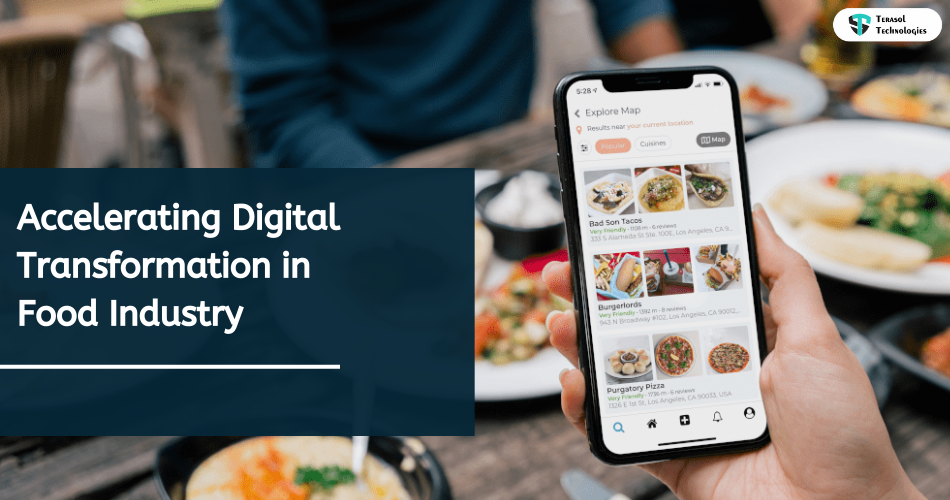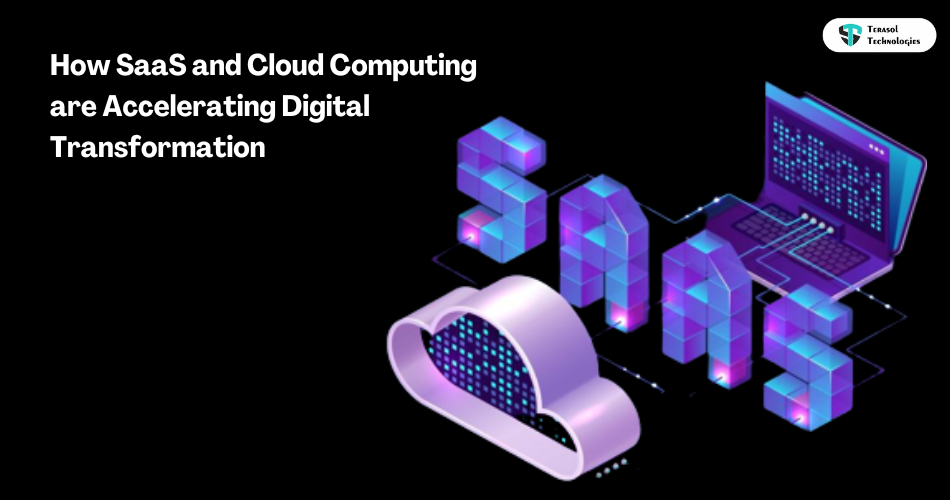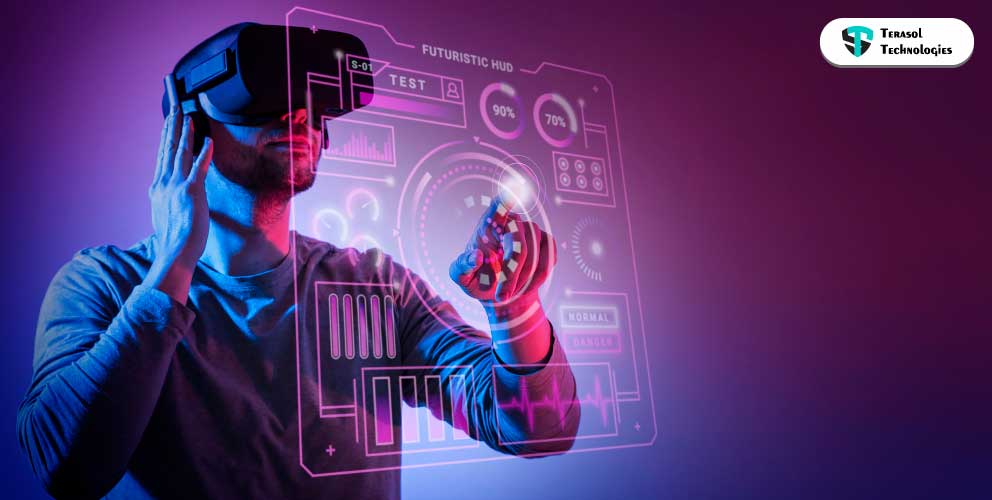Technology isn't typically the first thing that springs to mind when thinking about meals. However, in today's charts, technology in the food sector is the most desired component!
As the saying goes, we are what we eat!
The food industry has welcomed new technology and mobile application-based services, which have significantly changed how this sector functions. Food tech was created as a result of the combination of food and technology thus leading to digital transformation in the food industry.
A recent ING analysis claims that technology aids in producing food more effectively to meet the needs of an expanding global population.
Some Quick Statistics on The Changing Food Trends
The globe is still experiencing problems and is eagerly awaiting solutions, with industries focusing on cutting-edge technologies and ideas to boost their bottom lines.
- VCs invested more than $39 billion into food tech companies in 2021. The rise in investment that the food technology sector is seeing serves as proof of it.
- According to Emergen Research, the global food tech market is anticipated to reach more than 342.5 billion US dollars by 2027 as a result of developing food industry innovations and consumer demand for healthier, less expensive, and safer food items.
- By 2023, it is expected that online grocery sales in the US would total $59.5 billion, with Amazonfresh, FreshDirect, NetGrocer, Walmart, and Safeway being the key players.
Food tech is revolutionizing the food sector by employing the newest technology to control production, distribution, and consumption as firms turn to technology to combat inflation and boost efficiency.

Why Is Technology Necessity for Success in the Food Industry?
As we all know in the past due to the risk of the virus spreading during the global lockdown, eateries were closed.
Preparing and eating homemade food daily became a bland and stressful activity.
We millennials crave to eat new food varieties, new cuisines, and yes the not-so-good fast food.
Basically, forcing us to adopt a new means of customer service through online food delivery.
We can transform food businesses into intelligent food brands that function effectively while providing instant pleasure to their customers.
How?
Simply by merging the latest technologies like the Internet of Things, cloud infrastructure, data analytics, mobility, etc.
It's a terrific moment for food inventors to take advantage of these market demands and grow quickly thanks to the possibility of food technology firms.
Want to know some of these advantages? There they are:
1. Easy access to food service:
Today's users can order food from a variety of platforms that sell food from different locations. They can also employ digital self-service kiosks in cafes and fast food outlets, AI-based assistants in virtual stores, and digital menus in restaurants.
Just like BILL App: A digital application suite solution for food service organizations. It apps allow staff to track orders, self-service kiosks, and e-Menu and drive-through services providing the best customer experience.
2. Improved Quality:
Consumers who get subpar, tainted, incorrectly labeled, or counterfeit goods may have a negative effect on your business and lose faith in your brand. In order to meet quality and safety compliance criteria, end-to-end traceability and quality documentation can be digitalized. This can stop products of suspect quality from reaching customers.
3. Traceability and Food Safety:
Consumers today are more concerned than ever about the quality of their food and are willing to pay more for organic and healthy goods. The full chain of a product's creation may be tracked thanks to blockchain technology.
It provides information on the manufacture of ready-to-eat food as well as raw ingredients, conditions of transportation, and storage.
For example FairFood, it uses blockchain technology to deliver insightful information about the goods' supply chain from farm to spoon.
4. More Reliable Demand and Supply Predictions:
Inventory management is a crucial component of the food industry that costs a lot to buy and store. Demand forecasting helps businesses streamline cash flow and lower risk.
You can estimate seasonal demand levels to stock up in advance by using software with advanced analytics to better understand the demands of your clients.
5. Sensible Usage of Food:
Many goods used in the food production process are wasted or discarded. This results in significant environmental contamination and unduly expensive prices for businesses. Food tech enhances the cooking process by providing workable options for the cost-effective utilization of food resources.
Software, smart scales, and cameras can be used to track and quantify food waste in kitchens.
For instance, the company Lumitics optimizes food production quantities, maintains yield rates, corrects purchasing choices, and creates menus based on consumer preferences.
Isn’t this a great step towards sustainability?
6. Personalized Services:
As each person is unique, it is hard to make an offer that is one-taste-favors-all.
Based on the user data gathered, it is simpler for businesses to use digital solutions to comprehend the interests and preferences of their target audience. Actionable information may help the food industry make wise decisions, allowing enterprises to provide personalized services.
Hence, making technology makes it possible for businesses to enjoy the rewards of digital transformation by building a solid foundation.
Various Sectors in Food Tech
Each stage of the food cycle has a corresponding subcategory within the larger ecosystem of technologies known as "food tech." Some of these sector under food tech are:
.png?width=465&name=Untitled%20(33).png)
1. AgTech
Startups use automated technology that eliminates manual labor, such as sensors, drones, and software, to improve the quality of crops. Artificial intelligence (AI) and machine learning are used to understand how effectively plants can develop. Fertilizer management, automated equipment, soil sensors, and water solutions are other aspects of agriculture technology.
2. Restaurant Tech
Restaurants, cafeterias, motels, and other food-related enterprises are considering automation to improve their operational efficiency. IoT technology is also being used by restaurants to manage supply orders and track ingredients from initial orders. Technology like smart menus, contactless payments, cooking robots, etc. is currently thriving in restaurants.
Restaurant owners may monitor the entire journey and monitor the storeroom temperature using sensors to make sure all safety regulations are met.
The set-and-forget technology in smart appliances helps make cooking simpler so that workers can make the most of their time while waiting for food to cook. Chefs can manage their time and orders with the use of kitchen automation technologies.
3. Delivery
Food transportation is a challenge for businesses as a result of supply chain disruptions. Technology is required to track and guarantee that food is packaged and transported securely due to the increased demand for direct delivery to consumers, including meal kits, restaurant and grocery delivery, and grocery delivery.
Technologies Propelling the Food Tech Industry
.png?width=950&name=Technologies%20in%20Food%20Tech%20%20(1).png)
1. Blockchain
A smartphone application built on the blockchain can improve food management by tracking and documenting transactions to uphold the industry's standards for food safety and quality. Additionally, blockchain technology aids in handling massive data and promoting brand transparency.
Supermarkets and hypermarkets are beginning to employ blockchain technology to ensure, for example, that their chicken meat is sourced from poultry that has not been given antibiotics.
2. Automation
Some of the advancements in retail sales include drones that monitor the display shelves and take real-time inventories, robotic waiters and cooks, and remote-controlled delivery vehicles. Restaurant technology that automates activities improves operations, expedites workflow, and lowers costs over time.
3. Artificial Intelligence
Chatbots powered by AI is being used by food-related smartphone applications to communicate with their users. Based on their eating habits and mannerisms, they provide meal recommendations. Additionally, chatbot support is available around-the-clock. On the strength of predictive analytics and machine learning technologies, the future of food technology aims to become more intelligent and individualized.
4. AR/ VR
Creative food visuals have lessened in importance as AR and VR have entered the food market. Today, transparency in the food industry is the most crucial factor. With the use of AR and VR, consumers can now associate the food they order with the number of calories it contains. By bridging the cultural divide, technology is also benefiting consumers.
5. Internet of Things
The food industry is going through some significant changes as a result of the availability and expansion of IoT solutions, particularly in terms of trends in food safety. Utilizing IoT technology, food production companies can maintain the highest standards of quality while ensuring that their products will always be of the same, higher quality, wherever they are.
Now you know with time these technologies will instead become a necessity than just a mere trend for digital transformation in food industry.
Some Use Cases on How Digital Transformation Can Do Wonders
1. DöhlerDöhler, a global manufacturer, marketer, and supplier of technology-driven natural ingredients and integrated solutions for the food and beverage sector, is headquartered in Germany.
The organization's digital transformation objectives were to increase efficiency and provide a competitive edge. In order to give its clients the visibility they wanted, Döhler worked to centralize and optimize its logistical operations.
The company was able to swiftly re-route goods during COVID-related shutdowns because it had visibility into the suppliers and ports that were impacted. Among the advantages of its digital transformation are: more openness throughout its operations, cost-effectiveness, increased output, and increased customer satisfaction.
2. AgshiftAgshift, an AI-based food tech business that aims to reduce global waste has an autonomous food inspection system that is the primary goal It helps autonomous quality assessment for food companies by combining its own deep learning models with computer vision and IoT.
The Future of Food Tech
.png?width=950&name=Technologies%20in%20Food%20Tech%20%20(2).png)
Let's talk about the important areas that are being driven by investments in and breakthroughs in food technology that will radically enhance the narrative of digital transformation in the food industry in the future.
The future of the food tech sector will be determined by innovations that can satisfy consumers' growing demands for convenience, health, product freshness, and environmental sustainability.
1. Consumer Food TechThis area of food technology investment focuses on the creation of both new and current technologies that are primarily marketed toward consumers. Nutrition-based technology that strives to meet customer preferences is the main focus of consumer food technology.
Fast-Food firms like McDonald's developed meatless burgers via beyond meat and began offering them on their menus.
2. Industrial Food TechA division of food technology that handles the business model is industrial food technology. Some businesses will need to concentrate on how to process, package, and transport wholesome and cutting-edge food because simply focusing on food would not be sufficient.
3. Tech in Food Supply Chain and ProcurementFast-casual restaurants are on the rise, and fast food chains are under pressure to reconsider their delivery strategies as a result of shifting consumer expectations for quality, convenience, and gourmet foods in food service. Consumer awareness of food fraud is rising, as are the demands for food traceability and records of procurement.
To meet these demands, there is now a compelling business case for innovation in the food supply chain. In this sector, innovators are concentrating on traceability, sustainability, enhancing freshness, and reducing food waste.
Additionally, future food technology will emphasize the meal's nutritional content, quality, taste, freshness, and sustainability.
Want to Take a Step Towards Transformation?
Do you want to invest in the digital transformation of your firm in the US or any other country or state, or maybe develop a food tech solution, the time is now!
Food service app development companies are working hard to provide their clients and customers with the best food technology and innovation, whether it be by deploying robots to serve or apps to deliver food, or systems to package it.
At Terasol Technologies, we take great pride in providing top-notch business solutions that help our clients get through their most difficult obstacles.
We have the whole digital transformation roadmap covered, from the main ERP solution to the supplemental management systems that will deliver extra advantages throughout your operation.
Do feel free to get in touch with us; we can make your ideas a reality!


